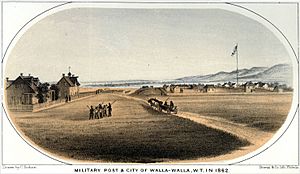Fort Walla Walla facts for kids
Quick facts for kids |
|
|
Fort Walla Walla Historic District
|
|

Fort Walla Walla in 1906
|
|
| Lua error in Module:Location_map at line 420: attempt to index field 'wikibase' (a nil value). | |
| Location | 77 Wainwright Drive, Walla Walla, Washington |
|---|---|
| Built | 1858 |
| Architectural style | Second Empire |
| NRHP reference No. | 74001985 |
| Added to NRHP | April 16, 1974 |
Fort Walla Walla is a historic United States Army fort located in Walla Walla, Washington. It was an important military base for many years.
The first Fort Walla Walla was set up in July 1856. Lieutenant Colonel Edward Steptoe and his soldiers from the 9th Infantry Regiment built it. A second fort was used later that same year.
The main, permanent Fort Walla Walla was built in 1858. It was next to a growing town called Steptoeville, which is now Walla Walla, Washington. In 1859, the government officially made the fort a military area. It included 640 acres for military use and more land for hay and timber.
Soldiers from the 1st Cavalry lowered the flag for the last time on September 28, 1910, closing the fort. However, it briefly reopened in 1917. This was to train soldiers for World War I. In 1921, the fort became property of the Veterans Administration. Today, 15 of the original military buildings are still there. The area now has a park, a museum, and a medical center named after Jonathan M. Wainright.
Contents
Who Served at Fort Walla Walla?
Many different groups of soldiers served at Fort Walla Walla over the years. These units helped keep peace and protect settlers in the region.
Some of the units included:
- The 4th Infantry Regiment (United States) (1856-1858)
- The 1st Dragoons (1856-1861)
- The 9th Infantry (1856-1861)
- The 2nd California Volunteers (1861)
- The 1st Washington Territorial Volunteer Infantry (1862-1865)
- The 1st Oregon Volunteer Cavalry (1862-1865)
- The 21st Infantry (1873-1875)
- The 2nd Cavalry (1884-1890)
- The 4th Cavalry (1890-1898)
- The 24th Infantry (1899), which included Buffalo Soldiers.
- The 9th Cavalry (1902-1904), also known as Buffalo Soldiers.
- The 14th Cavalry (1905-1908)
United States Army Indian Scouts also worked with the troops from Fort Walla Walla. Many of these scouts were from the Nez Perce tribe. They were very helpful and even saved many soldiers during the Battle of Pine Creek.
Important Battles and Events
Soldiers from Fort Walla Walla took part in several important events.
The Battle of Pine Creek
In May 1858, Lieutenant Colonel Steptoe led troops north. They were investigating reports of miners being harmed. However, they were attacked by a group of Spokane, Palouse, and Coeur d'Alene Indians. This happened near what is now Rosalia, Washington. The soldiers had to retreat.
The Battle of Four Lakes
In August 1858, Colonel George Wright led soldiers from the fort. They went to the area between present-day Cheney and Medical Lake. Colonel Wright's troops captured 800 horses from the tribes near Liberty Lake. Horses were very important to the tribes. After this, the fighting stopped.
The Nez Perce War Battles
In 1877, soldiers from Fort Walla Walla were involved in the Nez Perce War.
- On June 17, 1877, soldiers fought in the Battle of White Bird Canyon. More than 30 U.S. soldiers lost their lives. There is a monument to them at the Fort Walla Walla Cemetery.
- Between July 3 and 5, 1877, soldiers also fought the Nez Perce Indians at the Battle of Cottonwood. Ten soldiers died in this battle. Their remains are also buried in the Fort Walla Walla Cemetery.
Roads That Led to the Fort
Several important roads connected Fort Walla Walla to other places.
Naches Pass Road
The Naches Pass road connected Fort Walla Walla and Fort Steilacoom. Local residents built it in 1853. It was a difficult road to use because it had very steep parts.
Fort Walla Walla–Fort Colville Military Road
This road followed an old native trail and fur trader's route. It went between Walla Walla and Kettle Falls. In June 1859, Captain Pinkney Lugenbeel and his soldiers improved the road. This helped them move wagons to build U.S. Fort Colville.
Mullan Road
In July 1859, U.S. Army Lieutenant John Mullan started building a long road. He followed the Fort Walla Walla–Fort Colville Military Road for a while. Then he built the 600-mile Mullan Road. This road went from Fort Walla Walla all the way to Fort Benton, Montana, through the Rocky Mountains.
Explore Today: Fort Walla Walla Museum
The Fort Walla Walla Museum is a great place to visit! It covers 15 acres of the Fort Walla Walla Park. The museum has four exhibit halls and a pioneer village with 17 buildings.
You can see living history performances on weekends during certain seasons. They also have special programs for children.
The pioneer village shows what life was like long ago. It includes several cabins, a blacksmith shop, schools, a jail, a train depot, and a doctor's office.
The exhibit halls display many interesting things. You can see military weapons, old tools, farm equipment, antique vehicles, and firefighting vehicles. There are also displays of old clothing and textiles.


